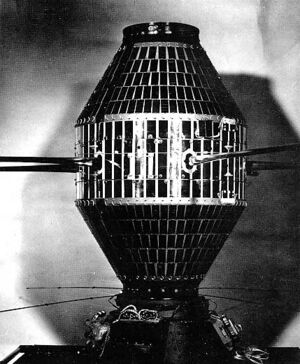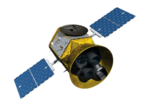Astronomy:Explorer 20
 Explorer 20. | |
| Mission type | Earth science |
|---|---|
| Operator | NASA |
| COSPAR ID | 1964-051A |
| SATCAT no. | 870 |
| Spacecraft properties | |
| Manufacturer | Cutler-Hammer |
| Launch mass | 97 pounds (44 kg) |
| Start of mission | |
| Launch date | August 25, 1964, 13:43 UTC |
| Rocket | Scout X-4 |
| Launch site | Vandenberg Air Force Base SLC-5[1][2] |
| Orbital parameters | |
| Reference system | Geocentric |
| Regime | Low Earth |
| Semi-major axis | 4,382.4 miles (7,052.8 km) |
| Eccentricity | 0.0109 |
| Perigee altitude | 540 miles (869 km) |
| Apogee altitude | 625 miles (1,006 km) |
| Inclination | 79.9° |
| Period | 104 minutes |
| Epoch | 25 August 1964 |
Explorers | |
Explorer 20, also known Ionosphere Explorer IE-A, Ionosphere 2, Science S-48, Topside-sounder TOPSI and Beacon Explorer BE-A, was an United States satellite launched as part of Explorers program. Its purpose was two-fold: long-term investigation of the ionosphere from above, and in situ investigation of ion concentrations and temperatures.
Spacecraft
Explorer 20 was a 97 pounds (44 kg) satellite designed by Cutler-Hammer's Airborne Instrument Laboratory under the management of NASA's Goddard Space Center. Its primary purpose was to measure ionospheric emissions from above ("topside-sounding"), between the satellite and about 200 miles (322 km) above the Earth's surface, where ionospheric electron concentration is at its highest.[3] This data could then be compared and correlated with ionospheric data collected from the ground. In addition, Explorer 20 would measure electron distribution, ion density, and temperature, and to estimate cosmic noise levels between 2 MHz and 7 MHz.[4]
Explorer 20 was a short cylinder capped at both ends by truncated cones. The satellite's primary experiment was a six-frequency ionospheric sounder: Six sounding antennas (three dipoles) extended from the satellite equator, one pair of 18.28 m (60.0 ft) antennas forming the dipole used for low frequencies, the other two dipoles consisting of four 9.14 m (30.0 ft) antennas.[4] The principal investigator for this experiment was the Central Radio Propagation Lab of the National Bureau of Standards.[3] An ion mass-spectrometer, mounted on a short boom, extended from the upper cone and measured ion concentrations and temperatures in the satellite's immediate vicinity. Explorer 20 also measured cosmic emissions using the noise signal from the sounder receivers.[4] This experiment was provided by the University College of London.[3]
It was expected that information gathered from Explorer 20 would help in the study of long-range radio transmissions, particularly the cause of periodic radio black-outs.[3]
Launch and Results
Originally planned for launch in March 1964, electrical issues with the Scout X-4 booster's harness and subsequent pad requirements resulted in five months of delay.[3] On August 25, 1964, at 13:43 UT, Explorer 20 was launched[5] into a near-perfect orbit, with an apogee of 625 miles (1,006 km) and a perigee of 540 miles (869 km), an inclination to the equator of 80°,[3] and a period of 104 minutes.[4] Upon reaching orbit, the antennas extended from the spacecraft, and tests of the primary and secondary experiments were completed within the first orbit.[3] The satellite was spin stabilized at 1.53 rpm just after antenna extension, with the spin axis initially very close to the orbit plane. After a year in orbit, the spin had slowed to 0.45 rpm.[4]
Explorer 20 was not equipped with a tape recorder, so data were only received when the satellite was in sight of ground telemetry stations, located to provide primary data coverage near 80° W plus areas near Hawaii (U.S.), Singapore, United Kingdom , Australia , and Africa. Data were recorded for periods of 1/2 hour to over 4 hours per day depending upon available power. The experiments operated satisfactorily for about 16 months, despite problems with telemetry and interference. The ion probe was rendered useless due to large spacecraft plasma sheath that developed around the spacecraft, and efforts to compensate proved fruitless..[4]
The satellite's responses to command signals became undependable after December 20, 1965, and the satellite transmitter often spuriously turned on. Though equipped with a one-year automatic satellite turnoff, this device was disconnected just prior to launch. Explorer 20 did not respond to a turnoff command after its performance became erratic.[4]
Instruments
- Fixed-Frequency Ionosonde
- Spherical Ion-Mass Spectrometer
- Cosmic Noise
References
- ↑ "IE". Encyclopedia Astronautica. Mark Wade. http://www.astronautix.com/craft/ie.htm. Retrieved June 9, 2018.
- ↑ "Letter dated 12 October 1964 from the Permanent Representative of the United States of America addressed to the Secretary-General". COMMITTEE ON THE PEACEFUL USES OF OUTER SPACE. http://www.unoosa.org/oosa/download.do?file_uid=1030. Retrieved June 9, 2018.[yes|permanent dead link|dead link}}]
- ↑ 3.0 3.1 3.2 3.3 3.4 3.5 3.6 "Explorer 20 Launch Succeeds". Aviation Week and Space Technology (New York: McGraw Hill Publishing Company). August 31, 1964. https://archive.aviationweek.com/issue/19640831#!&pid=24. Retrieved August 28, 2019.
- ↑ 4.0 4.1 4.2 4.3 4.4 4.5 4.6 "IE-A". NASA Space Science Data Coordinated Archive. https://nssdc.gsfc.nasa.gov/nmc/spacecraft/display.action?id=1964-051A.
- ↑ McDowell, Jonathan. "Launch Log". Jonathon's Space Report. http://planet4589.org/space/log/launchlog.txt.


